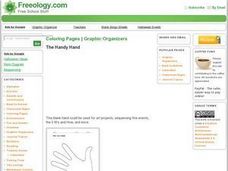Curated OER
The State of "No Child Left Behind"
Your class can read about the changes Obama considered making to Bush's No Child Left Behind Act. After reading the article, pupils answer 13 questions that ask, who, what, when, where, and why.
Curated OER
Cute, Colored and Contentious
Whether your class responds to the blog linked to this article, or just answers the nine related questions, they're in for an eye-opening read. Pupils consider animal rights as they read a New York Times article about two men who have...
Curated OER
Doors Open for Female Marines
What do your kids think about female Marines? They can explore this idea by reading the related New York Times article and by answering each of the seven comprehension questions. A learner-driven blog is located at the bottom of the...
Nosapo
Family Titles, Pronouns, Writing about a Person
How is your grandmother related to you? How is your cousin related to your grandmother? Learn about family relationships and pronouns with an activity that guides pupils to write two short narratives about members of their families.
Curated OER
Who, Where, When, What & How
In this questions activity, students write 'who, where, when, what, or how' for the underlined word or phrase. Students complete 8 examples.
Curated OER
Unit VII Energy: WS 1 Qualitative Analysis - Pie Charts
For each of eight diagrams of objects in motion, physics masters draw pie charts to depict the changes in energy. For each they must identify the energy conditions at each position. This is a unique learning exercise, perfect for...
Curated OER
WS 3.3 Atomic Weight and Ions
In this atomic weight and ions worksheet, students answer questions about isotopes of atoms and how it relates to atomic weight. They also write out oxidation or reduction reactions for given atoms undergoing loss or gain of electrons.
Curated OER
WS 7.1 Kinetic-Molecular Theory of Gases/Pressure
In this kinetic molecular theory worksheet, students summarize the points of the kinetic molecular theory, they answer questions about pressure, and draw diagrams to show how suction cups, drinking straws and barometers work.
Oxford University Press
Language Focus: Interrogative and Demonstrative Pronouns
Work on who, what, where, and how with several grammar activities. Additionally, kids complete sentences with demonstrative (relative) pronouns based on whether items are close or far away.
Curated OER
Who, Where, When, What & How
In this question words learning exercise, learners read the phrases and write the correct question word for each phrase. Students complete 8 examples.
Curated OER
Beginning Forming Questions-- "How"
In this forming questions worksheet, students put the words in each box in order to form a question that begins with the word "how". Students write the questions on the lines.
Curated OER
WS 9.9 Presentation Questions
In this presentation worksheet, students answer questions about five different topics presented in class. These include acid rain, acid etching, pH testing, cave formation and kidney stones.
Curated OER
Question Words
Practice interrogative pronouns with your ESL class in this activity. Ten questions provide parts of interrogative sentences for learners to complete with words like "what," "who," and "how." The worksheet would be a great class quiz or...
Curated OER
Questions Words
For this question word worksheet, students choose the correct question word (who, what, where, when, and how) to complete a sentence. There are ten multiple choice questions.
Curated OER
Give 'em a Hand
In this graphic organizer worksheet, students use the shape of the hand to find the who, what, where, when, and why for a text. Students write their answers in the fingers.
Curated OER
WS 5.2 Kinetic Theory-Temperature and Volume
In this kinetic theory worksheet, learners are given fifteen questions about gases and their kinetic energy, how temperature effects kinetic energy, and the results of changing conditions of gases on the kinetic energy. They convert from...
Curated OER
WS 5.6 Graham's Law
In this gases activity, students use the concepts of Graham's Law of diffusion to determine the velocity of gases and molecules. They describe kinetic energy and how it relates to the mass and velocity of objects.
Curated OER
Nonfiction Text: Comprehension Practice
A New York Times article about a 15-year-old style maven who in 2011 launched the fashion magazine "Rookie," based on her blog, makes high-interest nonfiction reading for secondary learners. This page asks 9 comprehension questions...
KERA
Matisse and Picasso
Discover Modernism through the eyes of artists. Over the course of six well-thought-out lessons, learners examine works by Pablo Picasso and Henri Matisse while completing a range of collaborative and hands-on activities. A great resource!
Curated OER
Lesson 8: Summarizing Information
In this summarizing information worksheet, students read a featured article, summarize the article, identify the story's five W's and one H, and identify appropriate relevant facts.
Curated OER
WS 2.5 Dimensional Analysis
Science students apply dimensional analysis to relate quantities in six different problems. They consider the cost of steak, a young man's growth rate, a medicine prescription, fuel efficiency, and more. This instructional activity is a...
Curated OER
WS 8.4 Percentage Problems
In this percentage worksheet, learners calculate percentages given various types of problems. They calculate percent of compounds in a solution, they calculate mass of compounds given percentages of solutions, and they percentages of...
Curated OER
WS 1.7 Density /Archimedes Principle
Archimedes' principle is practiced as chemistry learners practice computing the density of different gases, liquids, and solids. Using a chart of standard densities, they also identify unknown materials by similar calculations. Fifteen...
Curated OER
WS 7.4 Ideal Gas Law
In this ideal gas law worksheet, students solve eighteen problems using the ideal gas law to solve for moles of gases, temperature of gases, pressure of gases or volumes of gases.























